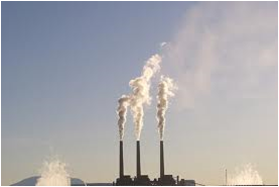Arkansas Air Quality Standards
The Clean Air Act (CAA) requires the Environmental Protection Agency (EPA) to set the limits of the National Ambient Air Quality Standards (NAAQS) to protect public health and welfare. The NAAQS regulates six criteria pollutants:
- carbon monoxide (CO)

- lead (Pb)
- nitrogen dioxide (NO2)
- ozone
- particulate matter (PM)
- sulfur dioxide (SO2)
The EPA periodically evaluates and sets concentration thresholds of the criteria pollutants and monitors them nationwide. The EPA must designate areas as "meeting" (attainment) or "not meeting" (nonattainment) the standard. Section 110 of the Clean Air Act requires states to submit a general State Implementation Plan (SIP) to attain and maintain the NAAQS and a specific plan to attain the standards for each area designated nonattainment. Each SIP submitted must undergo reasonable notice and public hearing and include enforceable emission limitations and other control measures, schedules and timetables for compliance.
The Arkansas Department of Environmental Quality (ADEQ) maintains air monitoring networks across the state, monitoring more than nine different parameters. Arkansas is one of a handful of states in the country that currently and consistently meets all federal air quality standards for criteria pollutants.
Small particulates PM2.5 and PM10 are currently regulated as the standards for particulate emission control. PM2.5 refers to particulate matter that is 2.5 micrometers or smaller in diameter while PM10 refers to particles less than 10 micrometers. In comparison, the average diameter of human hair is about 70 micrometers. This group of smaller particles is of concern because they present a risk to both human health (e.g. asthma, bronchitis, acute and chronic respiratory symptoms) and the environment (e.g. visibility impairment).
By recent ruling, greenhouse gases fit within the definition of an air pollutant under the Clean Air Act.
Ozone Action Days
![]() Ground-level ozone is harmful to human health and plant life and is created by emissions
from man-made and natural sources. Breathing high concentrations of ozone can cause
shortness of breath, coughing, headaches, nausea, and eye and throat irritation.
It is especially dangerous for children, the elderly and people with lung disease.
Every year from May through September, ADEQ works with other Arkansas agencies to
present Ozone Action Days to make air quality information available to Central Arkansas. Participating counties
include Pulaski, Faulkner, Lonoke and Saline. Advisories and alerts are issued when
prolonged outdoor exertion is unhealthy for sensitive groups or everyone, respectively.
Tasks that tend to increase ozone levels, such as using oil-based paints or gasoline-powered
lawn equipment, should be reduced during hot and sunny daytime periods.
Ground-level ozone is harmful to human health and plant life and is created by emissions
from man-made and natural sources. Breathing high concentrations of ozone can cause
shortness of breath, coughing, headaches, nausea, and eye and throat irritation.
It is especially dangerous for children, the elderly and people with lung disease.
Every year from May through September, ADEQ works with other Arkansas agencies to
present Ozone Action Days to make air quality information available to Central Arkansas. Participating counties
include Pulaski, Faulkner, Lonoke and Saline. Advisories and alerts are issued when
prolonged outdoor exertion is unhealthy for sensitive groups or everyone, respectively.
Tasks that tend to increase ozone levels, such as using oil-based paints or gasoline-powered
lawn equipment, should be reduced during hot and sunny daytime periods.
What if the air outside smells bad?
Odors from livestock production systems are generally regarded as nuisance pollutants which are not regulated under the Federal Clean Air Act nor are there Arkansas air quality regulations that specifically address livestock production.
Regulation 5 "Liquid Animal Waste Management Systems" is administered by the ADEQ's Water Division and "provides management, operational and maintenance procedures necessary to ... control to the degree practicable the generation of offensive odors by regulated confined animal operations." Aside from minimal distances between animal housing, manure storages, land application sites and neighbors, the specification of odor control practices is the responsibility of the professionals writing the ADEQ-approved waste management plans.
Publications
| Number | Title |
|---|---|
| FSA1070 | Understanding Air Quality Standards |
| FSA3007 | Managing a Livestock Operation to Minimize Odor |
Additional Resources
Relevant Arkansas Air Quality Regulations
|